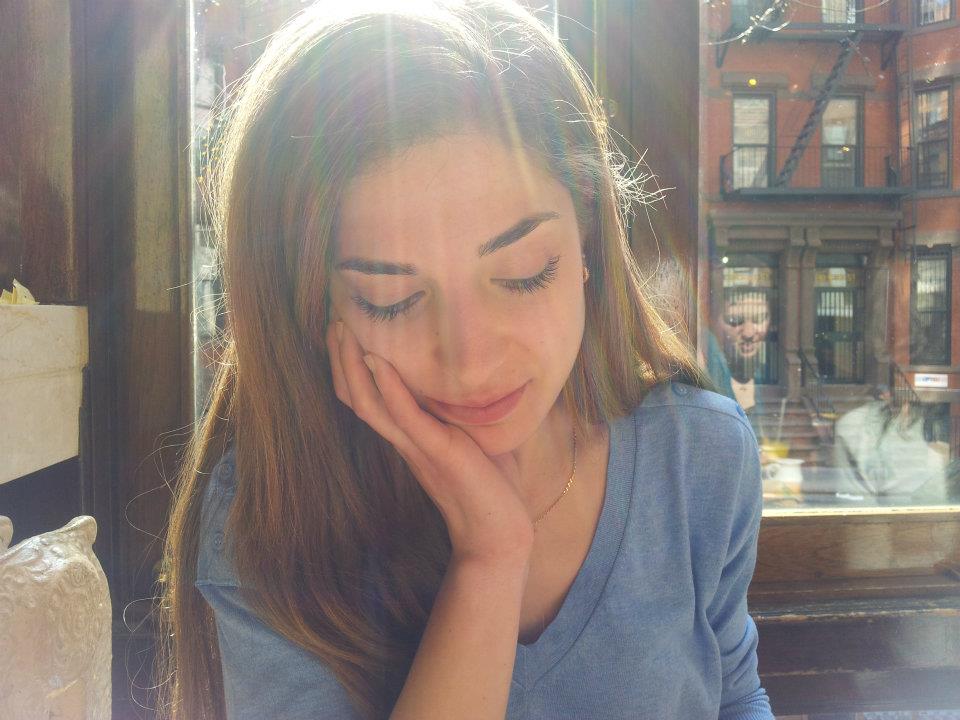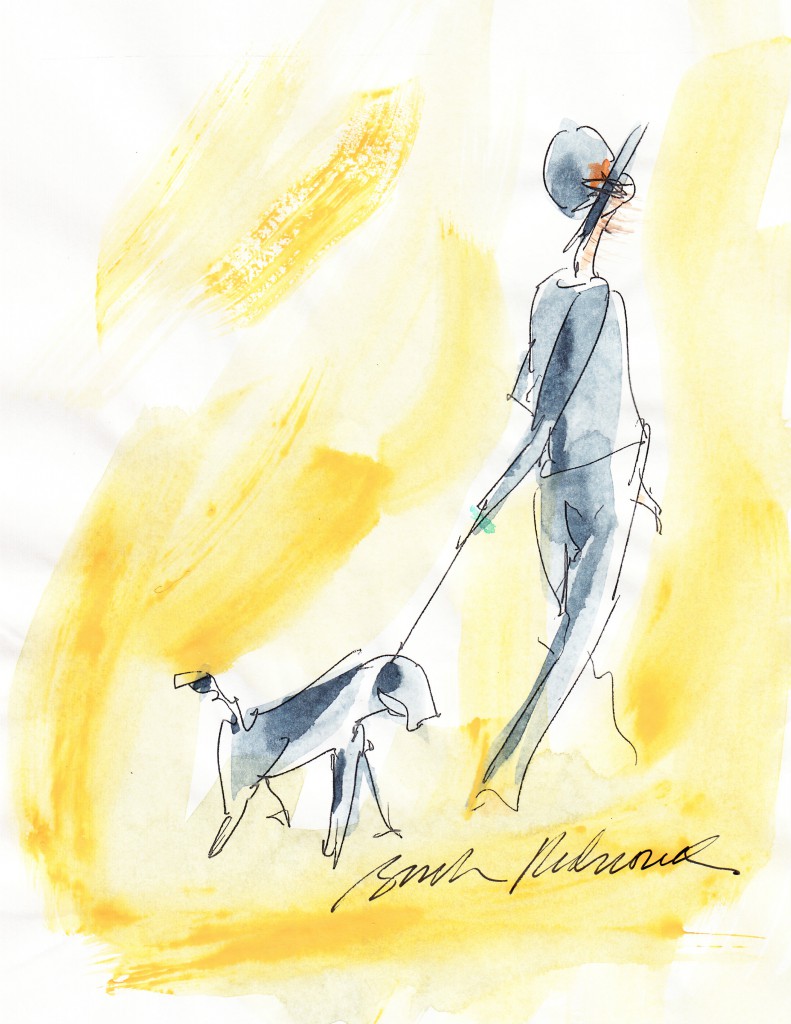On Unnecessary Women: an evolution of the muse
19 Friday Jun 2015
Tags
An Unnecessary Woman Rabih Alameddine, Beatrice Portinary Divine Comedy, Divine Comedy Dante, Evolution of the Muse David Halle, Margherita Luti Divine Comedy Dante, muse, When I Met my Muse William Stafford, Zeus Mnemosyne Calliope Clio Erato Euterpe Melpomene Polymnia Terpsichore Thalia Urania
Share it
“On Unnecessary Women” by Yara Y. Zgheib. ©2015 Yara Y. Zgheib. Published with permission. All rights reserved.
“I glanced at her and took my glasses off—they were still singing. They buzzed like a locust on the coffee table and then ceased. Her voice belled forth, and the sunlight bent. I felt the ceiling arch, and knew that nails up there took a new grip on whatever they touched. ‘I am your own way of looking at things,’ she said. ‘When you allow me to live with you, every glance at the world around you will be a sort of salvation.’ And I took her hand.” —William Stafford, When I Met my Muse
In his masterpiece of a novel, An Unnecessary Woman, Rabih Alameddine writes, “There are two kinds of people in this world: people who want to be desired, and people who want to be desired so much that they pretend they don’t.” His heroine is a childless, seventy-two year old Beiruti divorcee who, in a small apartment overrun with books, muses on a lonely, unnecessary life that inspired no one and nothing.
Derived from 12th century Old French, the verb to muse is “to reflect, ponder, dream, wonder,”—to be absorbed in thought. At its root, a “muse” is actually a noun; a feminine noun that means divine and artistic inspiration, a protector of creative thoughts.
Once upon an ancient Greek time, Zeus and Mnemosyne, the goddess of memory, had nine daughters; nine muses, patrons of the arts and sciences. The ancient Romans gave them each a specific task: Calliope was poetry; Clio, history; Erato, art; Euterpe, music; Melpomene, tragedy; Polymnia, hymns; Terpsichore, dance; Thalia, comedy; and Urania, astronomy.
Female, beautiful, elusive, the muse came to represent the object of every man’s desires, and the epitome of every woman’s aspirations. “The muse is a lovely, slender woman with a deathly pale face, lips red as rowan-berries, startlingly blue eyes and long fair hair…”
In his Divine Comedy, Dante was the first to transform the muse from the spiritual being of antiquity to an actual human. Her name was Beatrice Portinari, a young girl he gazed at amorously for years in the streets of Florence. Fifteenth and Sixteenth Century Italian Renaissance artists made the muse even more earthly; Raphael may have painted her as a Madonna, but his model, and lover, was fornarina Margherita Luti, the baker’s daughter.
“To be a muse is to be a wonder in someone else’s eyes, flaws and all.” To inspire great art, great music, great literature, awe, fear, love, lust. Is that not what every woman wants?
And yet.
A muse is always silent. She inspires, but she herself does not create. And once she has inspired, she becomes unnecessary. Like a lover who, in the dull light of mornings and every days, loses the luster that once made her more than just human. That is perhaps why most artists marry their art, never their muse. Great works are eternal; muses are not.
I think of the women I cross in the street, far cries from the muses any imagination would conjure up. The giggling schoolgirls, the respectable wives, the flustered mothers. The dinner makers, the bed tuckers, the story readers and the tear wipers. The multitaskers, the quiet sufferers, the tired. The crow’s feet on once doe-eyed faces.
Most women, real women, are not muses. But truthfully, I do not think they aspire to be. To be immortalized in a painting, sculpted onto a pedestal, imagined centuries later by a stranger leafing through a book of poetry would, of course, be nice, but a woman’s wants, my wants, are simpler.
“I didn’t dream of becoming a star, but I thought I might have a small nonspeaking role in a grand epic, an epic with a touch of artistic credentials. I didn’t dream of becoming a giant—I wasn’t that delusional or arrogant—but I wanted to be more than a speck, maybe a midget. I could have been a midget.” ― Rabih Alameddine, An Unnecessary Woman
In his study of the “Evolution of the Muse,” UCLA professor David Halle says that the concept of the muse is part of the Romantic tradition, and ours is just no longer a romantic age. A woman does not want to be admired; she wants to be seen. Not immortalized, heard. Not coveted, needed.
Perhaps all a woman really wants is to be necessary.
To the woman I call every morning, and the woman with whom I once shared a bedroom and a childhood. To the very flawed, very human, very beautiful women who inspire me:
I cannot paint, nor should I ever sing, but I can write. And I am writing this for you. And for a man who, more than two years ago, decided he needed me.
 Born in Lebanon, Yara Y. Zgheib has traveled and lived in Glasgow, Washington D.C., and Paris, the city that forever has her heart. She is a Fulbright scholar with a Masters degree in security studies and an all but completed PhD in international affairs and diplomacy. More importantly, she is a writer, a political analyst, a daydreamer, and an avid tea drinker.
Born in Lebanon, Yara Y. Zgheib has traveled and lived in Glasgow, Washington D.C., and Paris, the city that forever has her heart. She is a Fulbright scholar with a Masters degree in security studies and an all but completed PhD in international affairs and diplomacy. More importantly, she is a writer, a political analyst, a daydreamer, and an avid tea drinker.
Yara is the author of “Biography of a Little Prince,” and has a second novel, “Letters I’ll Never Send,” scheduled for release in 2015. Her blog, “Aristotle at Afternoon Tea,” is a compilation of weekly essays on politics, art, culture, economics, literature, philosophy, and chocolate… her idea of a smart conversation over afternoon tea. For more information about Yara, visit: (Aristotle at Afternoon Tea)
You may also enjoy A Woman’s Paris® post The Impossible Legacy of the Perfect Parisian Woman by Edith de Belleville, who is both French and Parisan to the core, unites the past and present in her exploration of the Parisian myth: the perfect French woman. The Parisian woman, writes Edith, is not just the cold image of a fragile and chic fashion plate on high heels. Being Parisian is a behavior in life. The unique, violent, and bloody history of Paris built the soul of the Parisian who has a strong personality and is proud of the beloved city she fought for.
Reframing the Future of France: The Outdated Nature of French Inheritance Laws by Eva Izak-Niimura, who has lived in Tel Aviv, Tokyo, New York and currently residing in Paris. “What constitutes a family?” asks Eva Izak-Niimura, “What is the cornerstone of our society? The definition of “family” continues to be an evolving topic. Yet, the “traditional” family is collapsing. It demonstrates an amazing capacity for survival in light of all revolutionary forces. There are, undeniably, many alternatives nowadays to “old fashioned” family values—gay marriage, French Pacs, single parenthood—a smorgasbord of possibilities. Nonetheless, the institution stubbornly persists. (French)
Vive La Femme: In defense of cross-cultural appreciation. Writer Kristin Wood finds Francophiles around the world divided by Paul Rudnick’s piece entitled “Vive La France” in the New Yorker magazine. As is often the case with satire, there is a layer of truth to the matter that is rather unsettling. Including comments from readers worldwide. (French)
What is a French Woman? by Canadian writer Philippa Campsie who writes about discovering Paris through its women. The vague undefined notion we have of Frenchness is at the very least empathically not English or North American. So the eternal mystery is not about appearances, as much as we may like to imagine that Frenchwomen look a certain way.
Colette: Gigi meets Anne of Green Gables, by Canadian writer Philippa Campsie who contemplates French novels and their heroines, and wonders if French fiction may well be the important key to the mystery of what makes Frenchwomen the way they are. Including a recommendation of books by Louisa May Alcott, Jane Austen, L.M. Montgomery, and Colette.
l’Américaine, by Parisian Eva Izsak-Niimura who writes about the myth of the unsophisticated and pathetically naïve American where book after book and article after article there is the lament of the hopeless quest of the American woman to resemble her French counterpart. (French)
French women do get wrinkles, by Parisian Eva Izsak-Niimura who writes about the super French myth of the coquettish French nymph—her “je ne sais quoi”—in her ballerina shoes, hair effortlessly tied in a messy chignon blowing in the wind, large sunglasses over her naked, no make-up, nevertheless beautiful eyes, and she then continues to define how we are all measured by it.
On Doing and Being by Yara Y. Zgheib. “La bohème.” It was French novelist Henri Murger who first romanticized the expression in his 1847 novel, ‘Scènes de la vie de bohème.’ For Murger it came to mean ‘a world of artists, social rebels, and radicals who rejected the comforts of the bourgeoisie, opting instead for poverty, and believing that any true experience demanded suffering. They were committed to a life of freedom, work, and pleasure, and eschewed the corruption and rotten values of conventional society.’ Trust the Parisians to elevate starving to death to an art form.
On Fifth Avenue, at Five in the Morning by Yara Y. Zgheib. In the legendary opening scene, a slender Holly Golightly in black Givenchy evening gown eats a Danish and peers into the windows of a closed jewelry store on a deserted Fifth Avenue in New York City. She has what she calls the “Mean Reds,” that errifying feeling you get when life has been unkind and the future is uncertain. “What we believe,” writes Yara “is not as important as why we believe.”
To the South of France with Love. Sara Horsley invites us into her world to share six weeks in Arles, France, during a study abroad program. There, she learned about the French culture and their respect and admiration of artistic expression.
A Woman’s Paris: A global gateway to everything French, by Eric Best (reprinted with permission from A Northeast Francophile, published by the Journal). While Barbara Redmond is far from an aristocratic jetsetter, she once thought of herself as a Francophile. A Woman’s Paris readers can expect posts of French art and literature, first-person stories from Redmond and contributors about travelling and interviews with authors.
Text copyright ©2015 Yara Y. Zgheib. All rights reserved.
Illustration copyright ©2014 Barbara Redmond. All rights reserved.
barbara@awomansparis.com



1 comments
Jennifer L Valle said:
February 6, 2019 at 12:22 pm
I absolutely enjoyed this article and agree wholeheartedly on your viewpoints of what it meant to be a muse. ..and what it meant to be a woman.